
What Is A Sales Funnel And How To Build A Profitable One For Your Business [2024]
To turn your prospects into paying customers of your business, you don’t need a magic wand but an efficient sales funnel that’ll do the work for you!
To move your audience from one stage to the next, you’ll need a unique product/service, an expert sales team, and brilliant content to bring it together.
Today, we’ll help you build your own funnel by showing you all you need to know, from the stages and content to measuring and optimizing your performance.
Need the perfect tool to start building the ultimate sales funnel that’ll turn your audience into loyal advocates? Try Moosend’s platform to capture and nurture your leads with beautiful landing pages and email campaigns.
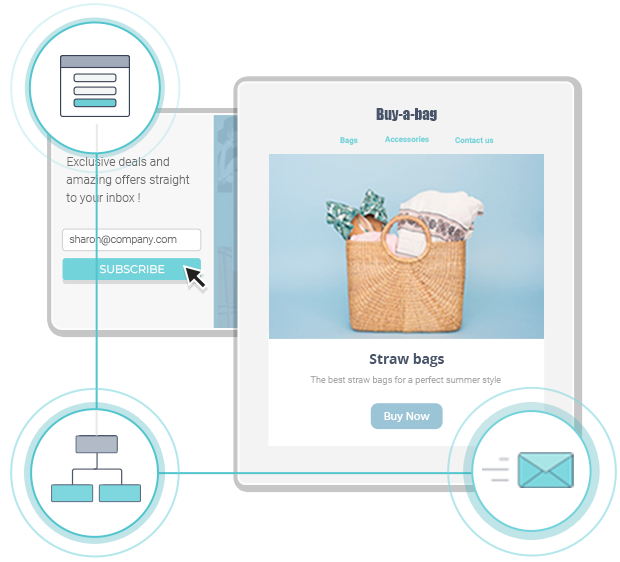
The easiest and most affordable email marketing and newsletter software!
What Is A Sales Funnel?
A sales funnel consists of all the necessary steps that a prospective customer has to take to become a loyal advocate of a brand. In essence, this type of funnel maps out the customer journey, dividing it into four stages: awareness, interest, decision, and action.
Compared with a marketing funnel, where the goal is to attract and engage customers, a sales funnel focuses on leading your prospects to action.
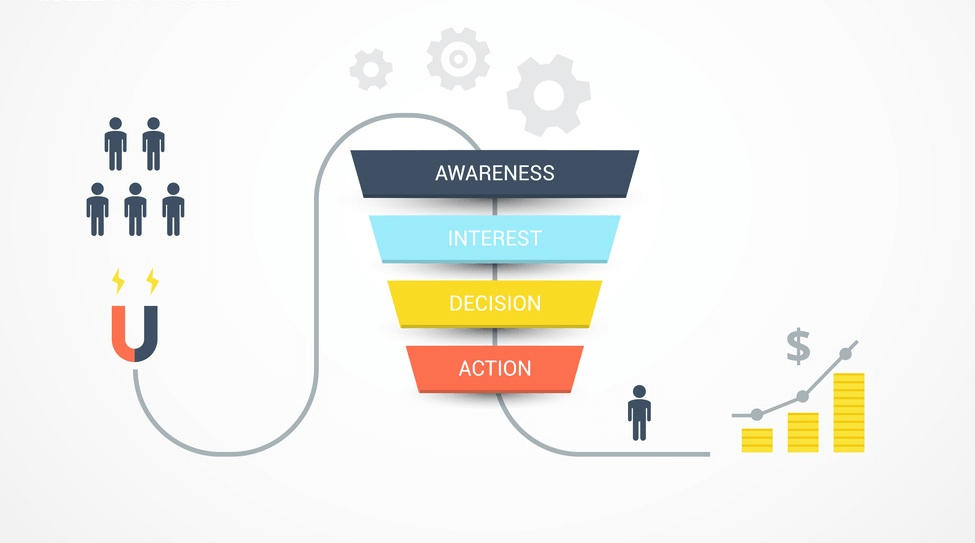
Why Do You Need A Sales Pipeline?
Nothing is random when it comes to the buying process. From the moment your potential customer finds out about you to the time they make their Xth order, you need to pay close attention to their decision-making process and study their habits.
An effective funnel will help marketers visualize the customer journey, find gaps in their marketing plan, and come up with viable solutions to improve it. Your end goal is to influence every step of the conversion funnel.
To achieve it, let’s break down the different stages first.
The Stages Of A Sales Funnel
First of all, when we look at a sales pipeline, we see three broader categories:
- Top of the Funnel (ToFu)
- Middle of the Funnel (MoFu)
- Bottom of the Funnel (BoFu)
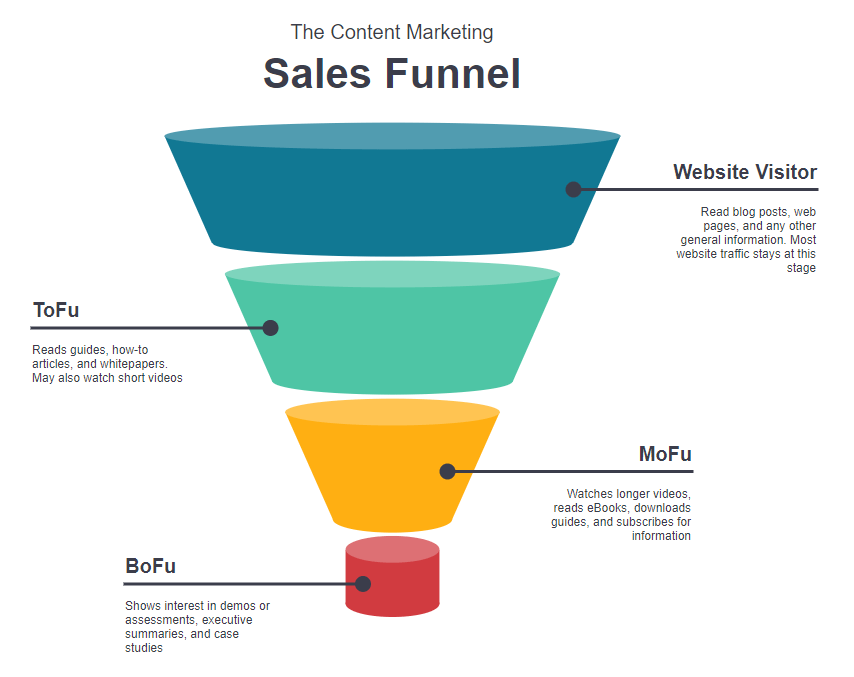
Marketers and business owners use these three stages to create a focused content marketing strategy for their new leads. For instance, when prospective customers discover your brand, they’re initially at the top of your funnel. To nurture them the right way, you need to deliver ToFu content like guides, videos, or white papers to get them interested in your product.
To give you a hand, let’s take a thorough look at the sales funnel stages and what types of content are ideal for each one of them:
Awareness Stage
This is the moment when people discover your product/service. Consumers usually find out about you when they search for something on Google, engage with social media content (posts, Facebook Ads, etc.), or hear about your product from friends and family.
In this funnel stage, marketers try to drive the new lead into the sales process by capturing their attention. If your offer is good enough, they will enter the sales funnel and start searching more about your business.
Best content type to use
To engage your target audience, you need interesting content. Here are the best types you can use:
- SEO optimized blog content
- Social media posts
- Infographics and e-books
- Videos and podcasts
- White papers
Interest Stage
During the interest stage, consumers are aware of their needs. However, since they aren’t sure about the solution, they won’t make a purchase. Instead, these leads will examine the available options to find the one that suits them best.
If you want to turn them into sales-qualified leads, though, you need to show them the value of investing in you. While it will take time to get them to the next stage, you and your salespeople should monitor these interest-stage leads to avoid losing a great opportunity.
Best content type to use
To lead them to a buying decision, make sure to show your expertise in your field and target unqualified leads with highly educational content:
- Lead magnets
- Comparison posts, videos, etc.
- Lead capture landing pages
- Downloadable content: case studies, templates, checklists, etc.
- Webinars
Decision Stage
In this sales funnel stage, your leads have successfully narrowed down their options, and they’re now ready to decide.
Since they still have more than one solution in mind, you have to play your best card and lead them towards your product/service. You can easily entice these leads by offering them unique discounts, free shipping, or gifts.
Best content type to use
Here, you need to deliver content that will give your leads more reasons to turn into paying customers. To do that, you can use:
- First-time purchase discounts for eCommerce stores
- Engaging explainer videos
- Email newsletters with reviews and testimonials
- Targeted offers
Also, don’t forget to create testimonial-infused campaigns to increase your credibility and show your potential customers that your product/service works. How? Just sign up for a free Moosend account and hop into the email editor!
Purchase Stage
Now your leads are ready to buy. To get them, you need to keep nurturing them with personalized messages. Also, providing stellar customer service is key to encouraging them to act.
While a great offer might do the trick, don’t forget to address your potential buyer’s pain points and highlight what they’ll achieve by becoming part of your brand.
Best content type to use
To close the sale, make sure to personalize your sales funnel messages and provide unique customer experiences (CX). Also, don’t forget to use urgency to make your target audience click on your calls-to-action (CTAs). You can do it with:
- Personalized email marketing campaigns
- Landing pages with irresistible value propositions
- Free trials and demos
- Sales calls
Retention Stage
If your audience reaches this stage, you have successfully managed to get them on board. Congrats!
The retention sales funnel stage is as important as the purchase stage. Here, you have to turn your new customers into recurring buyers. As customer retention is more profitable than acquisition, investing in a solid retention marketing strategy is crucial to ensure the survival of your business.
Best content type to use
To hack retention, you can use the following:
- Email newsletters with extra tips/how-tos
- Special offers for recurring customers
- Loyalty rewards
Now, let’s see a funnel example to help you identify a winning sales process.
What Does A Successful Sales Funnel Look Like?
Let’s say you run an eCommerce business that sells hair products for women. After thorough research, you found out that your target audience is females between the ages of 20 and 30.
Awareness: Since 72% of young females are Facebook users, you decide to create a Facebook lead ad to target them.
Interest: When they click on it, you redirect them to a landing page with an irresistible offer. To get it, they will have to give you their email address.
Decision: If they do, you will add them to one of your email lists. Well done! After segmenting your new subscribers, you start delivering email campaigns with useful tips, hair care routines, quizzes, and more.
Purchase: After nurturing them for a while, you decide to send a first-time discount to seal the deal. Amazed by the offer, some of your subscribers click through and buy your hair products.
Retention: Of course, your job doesn’t stop there. Now your goal is to target your new customers with post-purchase content. This way, you will effectively increase your retention.
As you can see, the above sales funnel works well, turning a visitor into a loyal customer of your brand.
How To Create A Profitable Sales Funnel
Now that you know what a sales pipeline is and how it looks, here are 6 easy steps to build your own:
1. Study Consumer Behavior
First of all, everything starts with data! If you want to nail your sales funnel, you have to collect enough information about your target audience. Not only that, but you also have to narrow down your customers to identify those who have the potential to buy your product.
As highlighted in our consumer behavior post, the easiest way to collect customer data is to:
- Send customer surveys
- Create a newsletter signup form
- Run a marketing analysis
- Conduct keyword research
- Track online behavior and more
These data collection methods will help you identify your prospective customers and discover more about their needs. When you have everything in place, make sure to visualize your target audience:
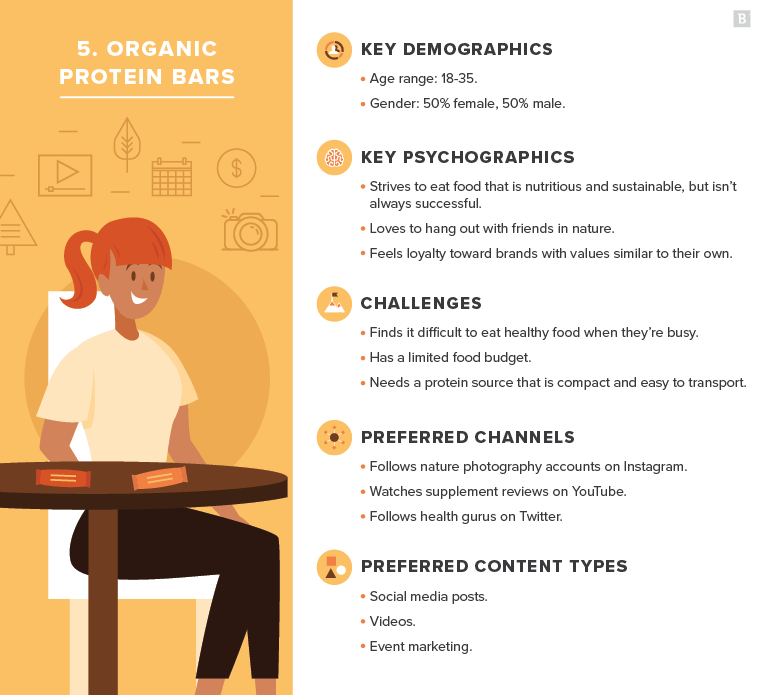
Also, to collect buyer behavior data, you’ll need a few powerful tools to make your life easier.
For instance, Moosend is an advanced email marketing automation platform and a top Clickfunnels alternative that will allow you to collect information through forms, manage your audience, and power up your sales funnel like a pro!
2. Create Buyer Personas
You collected the data. Now what? Well, apart from defining your target audience, you can use the info to create and improve your buyer personas. In short, a buyer persona is a detailed representation of your ideal customer, i.e., the person who has all the right characteristics to purchase your product.
Creating these personas is essential to build a sales pipeline that will provide consumers with the right customer experiences. Below you can see a simple buyer persona example:
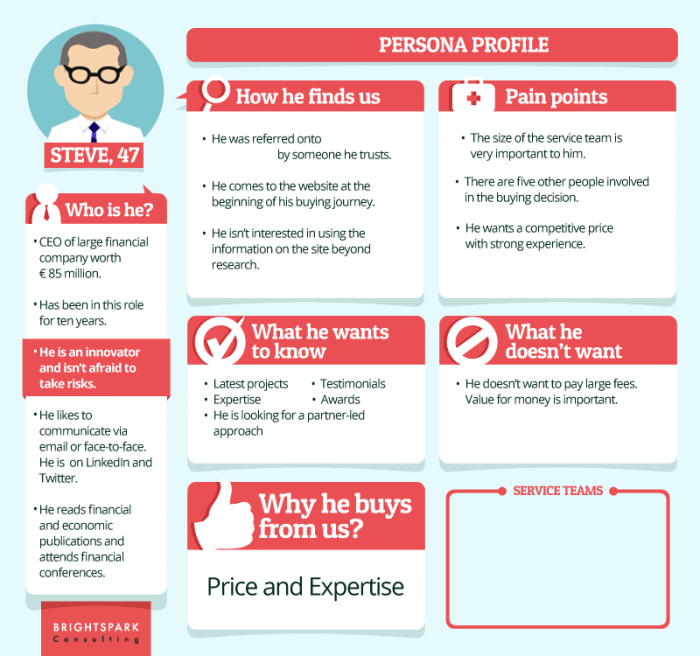
After creating your persona profiles, you can distribute them to your marketing and sales reps to power up your digital marketing game and skyrocket your conversion rate.
3. Design Lead-Generating Landing Pages
Landing pages are the best weapon you can use to move your audience through your sales funnel. As you know, lead-generating pages will capture your audience’s attention and make them part of your email list.
To create efficient landing pages for your sales pipeline, don’t forget to:
- Come up with an irresistible value proposition
- Use high-quality visuals
- Add compelling landing page copy
- Highlight the benefits of taking action
- Add social proof (testimonials, star ratings, etc.)
- Have a clear CTA button
If you put all these together, you’ll design a landing page that’ll look like this:
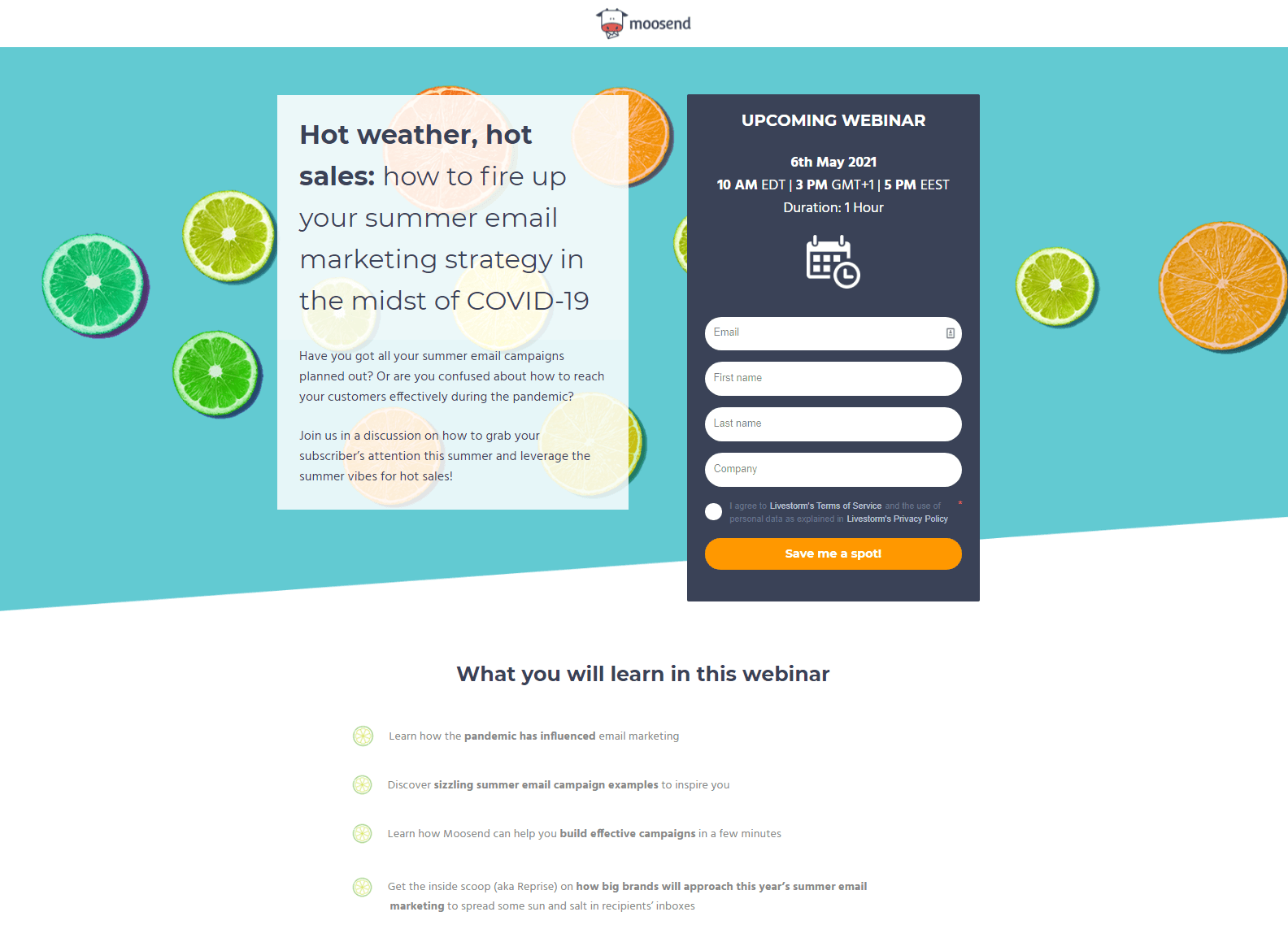
Linking your pages to Facebook or Google Ads is a clever way to increase your lead gen and show your potential customers why they need to invest in your product/service. Like the above example, make sure to use compelling language and a bright CTA to avoid losing leads. Also, if you need more inspiration, don’t forget to check other landing page examples!
Now let’s see how to nurture your new leads after they join your email list.
4. Set up a Drip Campaign Series
Email marketing is one of the most cost-efficient digital marketing channels ($49 for every $1 you spend on it) to nurture new subscribers and turn them into loyal supporters of your brand. To get the most out of it, you can create targeted campaigns for your sales funnel. However, a single email isn’t going to cut it.
What you need is a smart email sequence to “drip” your content at the right time! Enter drip campaigns, a series of emails that will help you nurture your subscribers and encourage them to click on your CTAs.
Here are some drip campaign types you can try to get your leads a step further down your funnel:
- Top-of-mind email drips: Keep your audience engaged throughout the sales process with engaging content.
- Educational sequence: Create emails with tips/lessons/how-tos to educate your subscribers.
- Promotional drip: Give them limited-time offers and discounts to convert them into first-time shoppers.
- Re-engagement emails: Win your disengaged leads back with special discounts.
Here’s an example from Leesa’s promotional drip, consisting of three email campaigns:
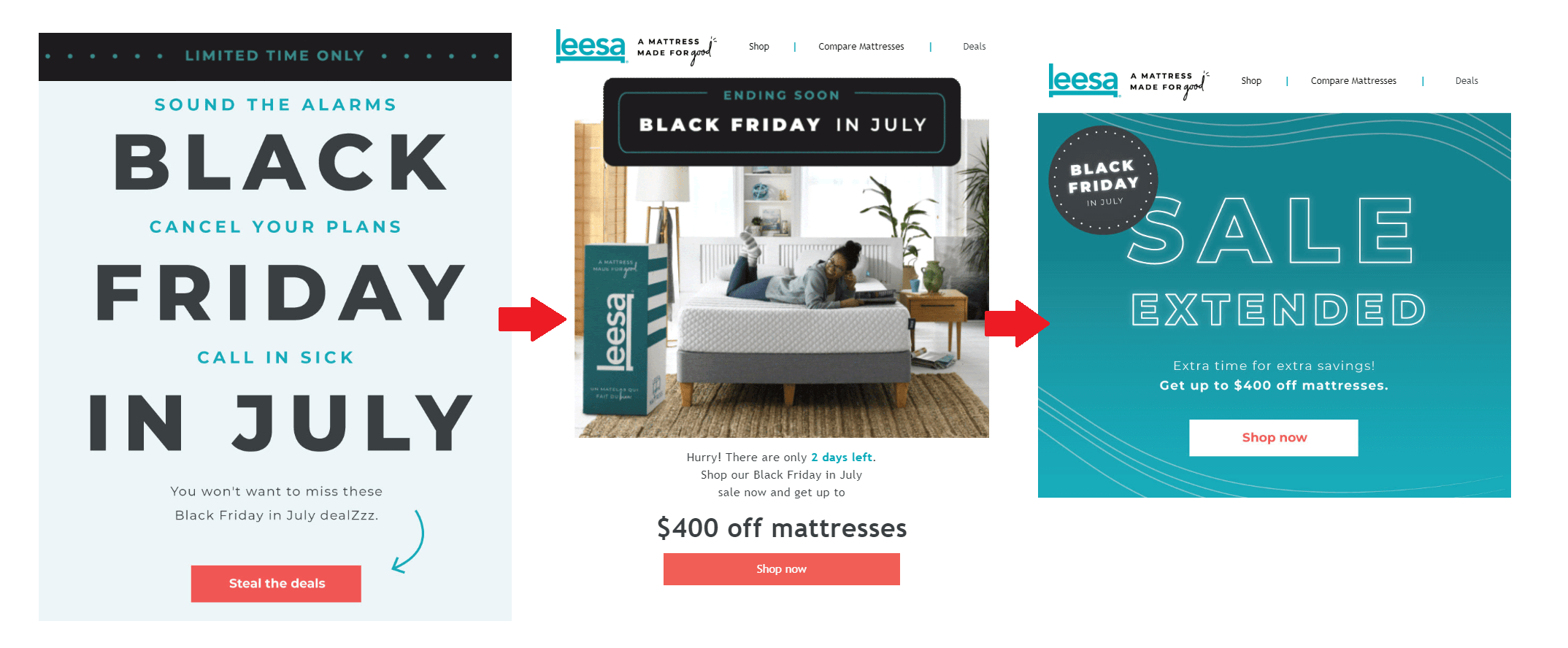
Every campaign is meant to entice Leesa’s audience and give them more reasons to click on the CTA, using urgent copy and an irresistible discount.
If you are serious about your email strategy, make sure to get a powerful email marketing service like Moosend to design equally appealing drip campaigns that will convert your potential shoppers!
5. Deliver the Right Message at the Right Time
When your sales pipeline starts having traction, you need to be extra careful about the content you deliver. For instance, sending an upsell email to someone in the awareness stage isn’t a smart move. Instead, target them with a beautiful welcome email to make a great first impression.
As we saw above, you have to create specific types of content for each sales funnel stage. To simplify the process, you can leverage the power of marketing automation. For example, you can set up a welcome email series to welcome new leads or a cart abandonment sequence to re-engage your cart abandoners.
Check out this abandoned cart email example by Ettitude:
Subject line: You forgot something silky-soft and sustainable…
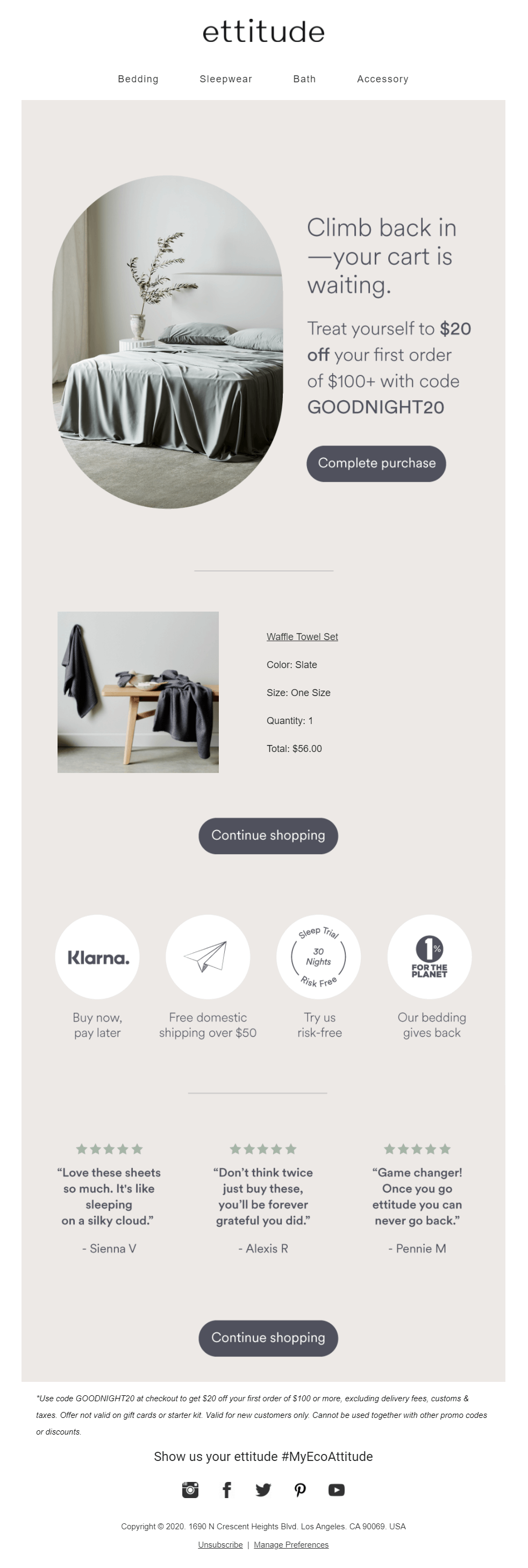
This way, you’ll manage to deliver the right message to the right person at the right time! If you don’t know where to start, create a Moosend account, hop into the visual workflow builder, and get started with marketing automation today!
6. Engage your Audience Every Step of the Way
Be it the loss of interest or the discovery of a better solution, your leads can exit your sales funnel without prior notice. To build a pipeline that will perform, you need to keep your audience engaged. A consistent email schedule will help you deliver follow-up messages to keep the customer/brand relationship alive.
Also, before you create your email plan, make sure to find out the best time to send your campaigns. Don’t forget, everything should be perfectly timed to get your message across without annoying your recipients!
Apart from sending emails, you can also leverage your social media profiles to approach your audience in a more personal way. Create beautiful posts, reply to their comments, and solve their problems through direct messages. As a result, you’ll maximize your efforts and offer your potential customers a better experience with your brand!
Using the Principles Of Influence For Better Sales
Of course, to get your leads from one stage of the sales funnel to the next, you need to find ways to influence them positively.
Coming from the “godfather” of influence himself, Robert Cialdini, let’s take a look at the six principles of persuasion you can leverage to move your customers a step further down your funnel:
Reciprocity
To use reciprocity, you have to show your leads the value of your business through unique customer experiences and excellent products. The more you keep them satisfied, the more they will invest in your business.
A simple example of reciprocity is offering your audience a gift or discount, either through your landing pages or online forms. As a result, your prospects will give you their email address in exchange.
Scarcity
Having a great product and selling it in large quantities is, of course, what every business wants. I mean, selling more will give you more, right?
Well, what if I told you that consumers are more likely to buy something when it is scarce? Offering a limited amount of items will influence them to get it no matter what. Why? Due to the fear of missing out on an incredible experience! To use this principle in full, don’t forget to highlight the benefits your potential buyers will gain by purchasing from you.
Authority
In the era of phishing and scamming, customers need to find credible products to satisfy their needs. To be under their radars, show them that your business is legitimate.
Establishing authority in your niche is essential to convince and convert your target audience. So if you have the knowledge and expertise, don’t forget to share it with them!
Consistency
Commitment plays a major role in increasing your sales. By getting your new customers to commit to your brand, you’ll slowly manage to turn them into loyal supporters of your business.
Of course, to make the most of this principle, you have to be consistent with your messaging and keep your promises. The more honest you are, the easier it will be to convert them!
Liking
The consumer/brand relationship has changed dramatically over the years. As a result, customers will now buy from brands they like and trust.
To build that connection, you need to create incredible stories that will humanize your business and make your audience fall in love with you. By using the principle of liking, you can encourage your audience to act and stay with you.
Consensus
Before they purchase your product, potential buyers will first look at customer testimonials to decide whether you’re worth their time and money.
Uncertainty can be a major obstacle, especially if you are new to the eCommerce or retail game. Nevertheless, using social proof will help you approach new leads and make them trust you before they make a purchase. And all these, thanks to the power of a few positive reviews and social media posts!
Now that we saw how to build your funnel and increase your sales, let’s look at another important aspect of funnel building.
Measuring The Success Of Your Sales Funnel
When you create your sales pipeline, you need to monitor its performance by tracking important marketing metrics. Here are the most significant indicators:
- Leads entered: The number of leads you gained and from which channels they entered your funnel (email, social media, Google search/Ads, etc.)
- Cycle duration: How much time it took them to move to the next stage.
- Customer acquisition cost (CAC): How much it cost to acquire new customers.
- Customer lifetime value (CLV): The net profit expected from each new buyer.
- Conversion rate: How many leads turned into loyal supporters.
As you can guess, the most crucial sales funnel metric is your conversion rate! You can easily calculate it by using the formula below:

Also, if you notice that your sales funnel isn’t giving you the outcome you expected, you should run various A/B tests to detect potential problems. Remember, the more you improve your pipeline, the better your results will be.
How To Optimize Your Sales Funnel
Measuring your sales funnel performance will lead to the final step, which is the optimization of your sales pipeline for better lead generation and conversions.
Before we take a look at the best ways to improve it, we should identify the common culprits of underperforming sales pipelines:
- You aren’t targeting the right audience.
- Your content isn’t engaging enough.
- The CTAs aren’t strong/straightforward.
- There’s friction during checkout/signing up.
To optimize your funnel, you need to address these problems and find ways to simplify the customer journey. Here are some simple ways to achieve it:
- Leverage referrals to increase your lead generation.
- Use retargeting campaigns to capture your site visitors.
- Re-evaluate your content marketing strategy.
- Improve your website CX to reduce friction.
- Train your sales reps to be up-to-date with current customer behavior patterns.
Of course, there are more tactics to improve your sales funnel. The best way to succeed, though, is to identify the problems and solve them as fast as possible. This way, you’ll manage to create a funnel that will run on autopilot!
Build A High-Performing Sales Funnel
From small businesses to large enterprises, creating a sales pipeline is essential to increase your revenue and ensure the survival of your business.
Knowing about the stages of your funnel will help you understand the customer journey and deliver content that will turn your leads into paying customers.
What’s more, with the right strategies, you can easily set up a profitable funnel that will perform! Just make sure that you get all the right tools for the job! Signing up for a Moosend account will help you capture, nurture, and convert those customers effortlessly.
Now it’s time to let your sales funnel work its magic and enjoy a funnel cake with extra whipped cream!



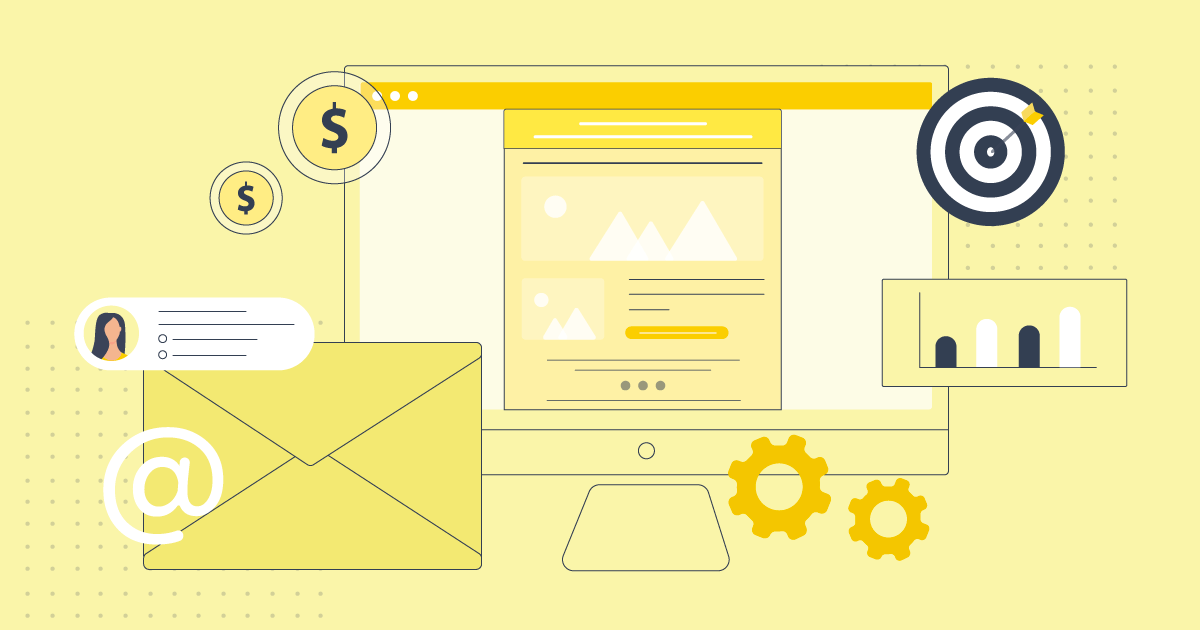
 Published by
Published by
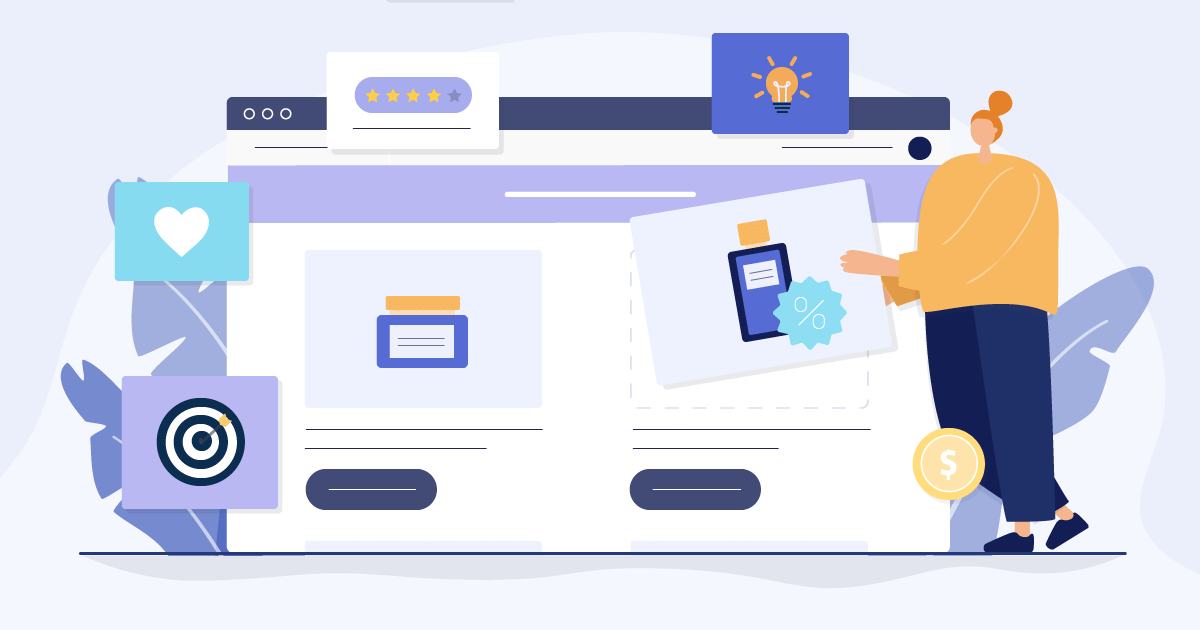

 Published by
Published by